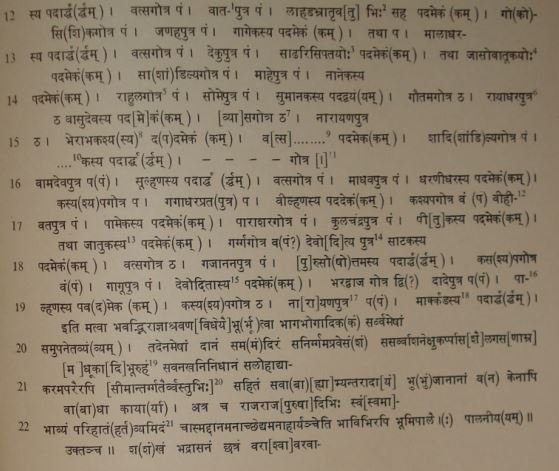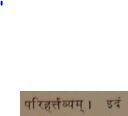|
SUPPLEMENTARY INSCRIPTIONS
TEXT[1]
[Metre ; Verses 1-3 Anushṭubh]

____________________
[1] This syllable is mutilated beyond recognition.
[2] The reading of the bracketed akshara is doubtful, and the construction is also grammatically faulty.
Should we read  ? ?
[3] The Sanskrit form of the second name is probably Śrīpati, or Ṛishiputra.
[4] The reading of the mātrās in these two names is not certain. May also be read as Jāsēvō.
[5] The first two letters are mutilated and the reading thereof is only from the traces left.
[6] The reading of the first two letters is again doubtful here.
[7] That is, Ṭhakkura.
[8] The reading of the consonant of the first letter of the name is doubtful, as also of the stroke after
ra, which may be taken either as a mātrā of ā, or a pṛishṭha-mātrā.
[9] About eighteen aksharas are lost here, and one point is used in the text to denote two lost aksharas.
[10] About ten aksharas are again lost here.
[11] Here the gōtra consisting of four letters cannot he made out.
[12] A curve above the first syllable shows it may also be read as Vi, and the reading of the second is
not certain.
[13] The details of this donee, as of some others, are not mentioned.
[14] The curve of the mātrā of the bracketed letter is omitted in engraving.
[15] Read  , or more probably, , or more probably,  , as in the preceding line. , as in the preceding line.
[16] A redundant stroke here, as also at the beginning of the next line, is probably put to show that name
is not completed here.
[17] The bracketed syllable, which was omitted at first, is written above the line, in smaller form.
[18] The rēpha of this akshara is cut on the preceding syllable, and the anusvāra sign on the one that
follows it.
[19] The three aksharas  , which probably denote hilly product, are not found in any other known
grant of the house. , which probably denote hilly product, are not found in any other known
grant of the house.
[20] All the letters in the bracketed are most crudely formed.
[21] Read  . .
|